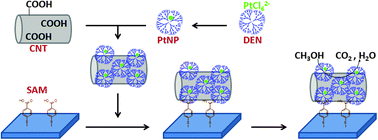Advantages of electrodes with dendrimer-protected platinum nanoparticles and carbon nanotubes for electrochemical methanol oxidation†
Abstract
Electrochemical sensors consisting of electrodes loaded with

* Corresponding authors
a
Graduate Institute of Applied Science and Technology, National Taiwan University of Science and Technology, 43 Keelung Road, Section 4, Taipei 10607, Taiwan, ROC
E-mail:
imae@mail.ntust.edu.tw
b Department of Chemical Engineering, National Taiwan University of Science and Technology, 43 Keelung Road, Section 4, Taipei 10607, Taiwan, ROC
Electrochemical sensors consisting of electrodes loaded with

 Please wait while we load your content...
Something went wrong. Try again?
Please wait while we load your content...
Something went wrong. Try again?
A. Siriviriyanun and T. Imae, Phys. Chem. Chem. Phys., 2013, 15, 4921 DOI: 10.1039/C3CP43636E
To request permission to reproduce material from this article, please go to the Copyright Clearance Center request page.
If you are an author contributing to an RSC publication, you do not need to request permission provided correct acknowledgement is given.
If you are the author of this article, you do not need to request permission to reproduce figures and diagrams provided correct acknowledgement is given. If you want to reproduce the whole article in a third-party publication (excluding your thesis/dissertation for which permission is not required) please go to the Copyright Clearance Center request page.
Read more about how to correctly acknowledge RSC content.
 Fetching data from CrossRef.
Fetching data from CrossRef.
This may take some time to load.
Loading related content
